Profound Knowledge: The Foundation of Science in the Art of Strategy, Innovation, and Enterprise Improvement.
TLDR – What is the System of Profound Knowledge?
The Deming Institute observes that the System of Profound Knowledge is “the culmination of Dr. W. Edwards Deming’s lifelong efforts to define a comprehensive theory of management”1. As it has evolved, the System of Profound Knowledge is the distillation of 4 streams of scientific theory knitted together into a practical frame of leadership – a way of thinking that can form part of a broader Leadership Philosophy (a topic to be covered elsewhere) towards rapid and continuous innovation and improvement. Since the impact of COVID, such a philosophy is no longer a “good idea” but potentially a matter of survival in both business and more broadly in social management.
The 4 Science Components of The System of Profound Knowledge are:
- Appreciation for a System
- Understanding Variation
- Theory of Knowledge (Learning)
- Psychology (Human Side of Change
Dr. W. Edwards Deming said, “Management needs a method!”. To get consistent productive results, you need a way to achieve them that is proven to work. Therein lies the problem! What is the proof?
We argue that a solid foundation of the science of improvement and evidence are required to build sustainable positive development in organisations, as much as in clinical and technology circumstances. However, managers with a deep knowledge of their chosen fields can still be prone to errors in driving change. Given that we are currently in the grip of another pandemic, Let us use an example of the management of the disease Cholera before 1854 to illustrate this point.
Before the Germ Theory of Disease was established in the late 1800s (Long after Louis Pasteur’s seminal paper in 18612), even the most learned people believed that diseases such as Cholera and the Bubonic Plague were caused by “Miasma”, that is “bad air”. As such, doctors, politicians and public administrators alike, often ascribed ineffective solutions to epidemics of the past.
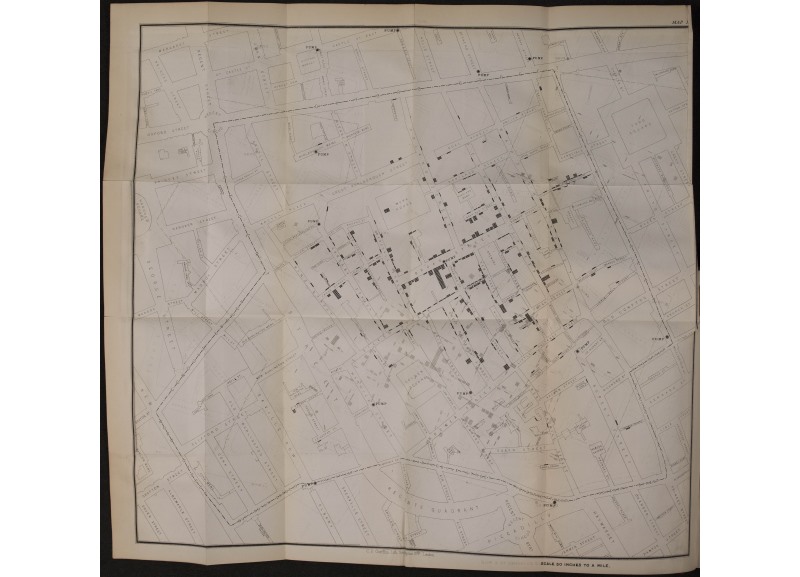
Map of Cholera Cases in Soho London, 1854 created by Dr. John Snow
It wasn’t until the third major UK epidemic in 1854 that John Snow (The doctor, not the Game of Thrones character) arrived at a better causal theory of Cholera transmission. By mapping out the cases in Soho, London, he was able to show evidence that the disease was carried through the contamination of water. With his findings he was able to convince the local council to remove the handle of the Broad Street pump, whereupon the incidence of Cholera dropped dramatically.
This was because people were forced to draw water from another source that was less contaminated with the pervasive sewerage of the time3. However, it still took until the dawn of the 20th Century for the Germ Theory of Disease to replace the Miasma theory, and for the changes he had proposed to be fully accepted. None-the-less, his work was one of the triggers towards the improved sanitation systems in London through the late 1800s.
We believe that organisational change should be founded on a Science of Improvement. It is the intersection between organisational and subject matter expertise, and the Science of Improvement, where real “magic” happens. This intersection has proven to lead to better strategy, accelerated innovation and more effective improvement. We will discuss the Accelerated Innovation and Model for Improvement (Aimi), along with effective Causal Analysis, amongst the topics of future articles. In this document, we focus on the most important theoretical underpinning to the Science of the Improvement – The System of Profound Knowledge.
For a more recent example of evidence from a business we have worked with, consider the US$120 million dollars of savings coming from small changes in the design of a product component made by a supplier. Were it not for the application of the System of Profound Knowledge, the company may not have seen the opportunity to work with the supplier to make the changes. This collaboration was a great example of where Subject Matter Expertise (from the supplier and the business), intersected with the Science of Improvement for accelerated innovation and improvement (from the business).
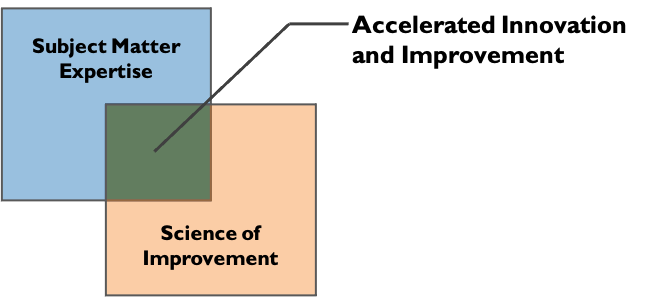
When driving change towards the Triple Aim of Healthcare or a business growth strategy bounded by the Triple Bottom Line of Business, the extreme degree of complexity requires organisations to take a different thinking towards meeting the challenges of today. This is where the science in the System of Profound Knowledge comes to truly add value.
Healthcare Triple Aim
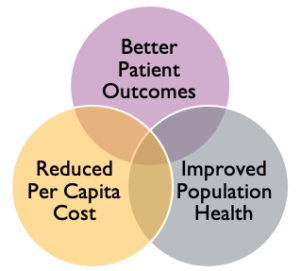
Business Triple Bottom Line
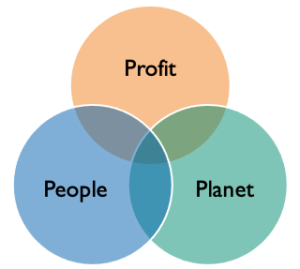
Going deeper into the System of Profound Knowledge
1. Appreciation for a System
Appreciation for a system begins with recognising that all organisations are an inter-linked set of process, technologies and people. The organisational system has inputs, provided by suppliers of materials, services and others, which are transformed into the outputs of the system – products, services and experiences the organisation provides to customers, clients, patients or beneficiaries. The people, processes and technologies are bound by the policy decisions that business leaders make, as part of the process management. Thus, we might describe 4 elements of a process system:
Operational Elements of an Organisation Process System
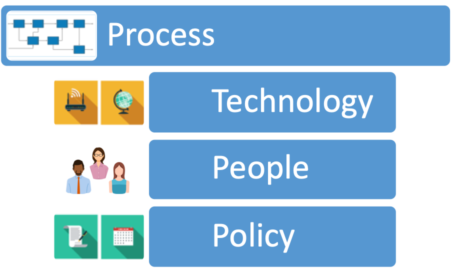
Processes (System) – All work is a process! Value is created by transforming inputs to outputs that address needs in society, whether from a public or personal health point of view, or the value of goods and services consumed. Processes in any organisation, can be connected together to form a Systems Map of linked processes.
Technology – The technology and tools used to conduct the work, such as computer hardware/software, cloud-based applications, measuring tools, robotics and communication equipment. Such technology is often integrated into the processes. For example, a prescription or invoice might be written with pencil on a piece of paper passed over to the recipient or recorded in a complex enterprise software system and communicated in some electronic format.
People –The people element has three parts: Firstly, there is the organisation structure; the roles and responsibilities that people have and the interplay between them, and how these relate to the processes. Secondly there is the knowledge and skills required by the people in their roles to run the processes and plan continuous improvements in them. Thirdly, there is the culture of an organisation, and particularly the mechanisms that motivate and engage the people in the system.
Policy – Defined in the Merriam-Webster online dictionary as “a definite course or method of action selected from among alternatives and in light of given conditions to guide and determine present and future decisions”4. Examples include decisions on opening/closing times, employment agreements, spending rules, triage guidelines, operational protocols etc. Such policies may act to align people, technology and processes, but if poorly designed may also cause inefficiencies and disengagement of staff and patients or customers.
To summarise, the people in the organisation use the technology to run the processes which create value. The policies promulgated by the organisation define the boundaries within which the people in the system can make choices and decisions.
2. Understanding Variation
Before we get into the discussion on variation, we must first know about measurement. What data is available to determine efficacy and system operational efficiency? What measures are applied to the outputs and inputs of the system?
Measures may come in different forms:
| Type of Measure | Healthcare: Redesign the Processes by Which Patient Flow is Managed Within Our Hospital | Inventory: Reduce the Costs of Inventory While Maintaining or Improving Service Levels to Customers | Hospitality: Increase the Turnover of Customers During Busy Periods While Maintaining or Improving Customer Satisfaction |
| Outcome | Diversions from the hospital; transfer time between units | Cost of Inventory | Number of Customers served; Revenue |
| Process | Number of units conducting bed huddles | Number of Inventory Checks | Time to seat; Time to pay; Number of customers to staff |
| Balancing | Admissions; Patient Satisfaction; Cost per bed | Stockouts, Customer Satisfaction | Customer Satisfaction; Staff stress levels |
Source: Adapted from Figure 5.1, Examples of Measures, from “The Improvement Guide: A Practical Approach to Enhancing Organizational Performance”, 2nd Ed., Langley, Moen, Nolan, Nolan, Norman and Provost, Ch. 5
When establishing a system of measures, it is critical to understand to what degree each measure is a lagging or leading indicator. For example, customer or patient satisfaction is very much a lagging indicator, dependent on a number of factors, which they in turn depend on factors earlier in the causal chain. By working our way back into the causal system, we can start to explore potentially predictive factors that lead to positive outcomes. Herein lies the benefit of Cause & Effect Analysis (perhaps using an Ishikawa or Fishbone diagram as a thinking tool) in preparing for and monitoring innovation and improvement.
Bearing that in mind, let’s get to the business of variation. All systems vary in terms of inputs, throughputs and outputs! Regrettably many managers do not think in such terms. In fact, in our daily lives, we experience such variation all the time, but then somehow forget when we enter the organisation, particularly if we are not on the front lines.
Our tendency is to expect consistency, often when we do not manage or even understand the causal factors that would create such predictability. “Prediction is the problem!” as Dr. Deming would say, or Nate Silver put it another way: “We need to stop and admit it: we have a prediction problem. We love to predict things—and we aren’t very good at it.”5. To do so, we must understand most, if not all of the factors, that influence the outcome and how they vary over time..
Dr. Walter A. Shewhart provided a theory of variation and a method that enables our ability to predict; the Shewhart Chart. The Shewhart Chart, sometimes called a Learning Chart or Statistical Process Control Chart, allows us to determine one of two types of variation:
Common Causes — those causes that are inherent in the system (process or product) over time, affect everyone working in the system, and affect all outcomes of the system.
Special Causes — those causes that are not part of the system (process or product) all the time or do not affect everyone but arise because of specific circumstances.6
A system dominated by common cause variation is said to be stable and predictable. A system that has special causes is unstable and not predictable.
For example, let’s say you leave your house every day exactly at 8:00am, walk down to the bus stop, take the bus to the train station, get on a train, get off at another station and walk the remaining way to your place of work. Nominally, you think the journey should take 45 mins, however you also remember getting there at 8:50 or 8:55, and sometimes, if you were “lucky”, you got there before 8:40. To learn more, you decided to keep a record of the time (in minutes) it took to get to work over the first 30 working days of the year. Based on this, we will now look at 3 different scenarios:
Scenario 1
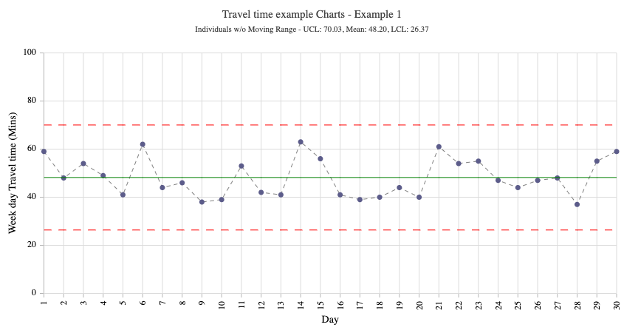
You follow the same route plan every day. The usual process occurs, with the longest trip taking 63 mins (you were a few minutes late that day) and the quickest taking only 37 minutes (you had time to duck into Pret for a take-away coffee that time). Nothing is special about that data, and if nothing changes, you have what is called “Common Cause” variation. In this system, the travel is predictable with an average around 48 minutes and could be as high as 70 and as low as 26 (if everything came together). Unless something unusual happens, with this process, to make absolutely sure you were never late, you would be wise to leave at 7:50am.
Scenario 2
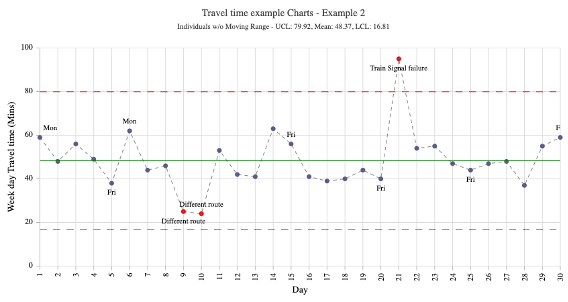
In this 2nd scenario, you kept the same process, following the same route (except for 2 days). Looking at this data set over the first 6 weeks of the year, you see that the data fell mostly into a range of between 18 mins and 79 mins, but there was one day that really stuck out. On the 21st day, there was an unusual event – The signaling at the train station malfunctioned and the trains were delayed that day. This is known as a Special Cause.
You can see from the graph that this point falls outside of the process limits and is a clear signal in the data that something “unexpected” happened. However, on days 9 and 10 you can also see that the travel time was exceptionally short twice in a row. The data analysis tells us that these were again Special Causes. Thinking back, you had decided to take a different route that you previously hadn’t tried, taking 2 longer distance bus trip routes.
The first bus stop is closer to your home than the train station, and somehow the bus timetables seemed to coordinate well. On those days your travel time was 22 and 21 minutes respectively. However, because these bus routes are often quite crowded, you decided to return to your normal process, with the average travel time around 48 mins (similar to scenario 1). Given the data above, you could not predict your arrival time with any certainty. From what you can see, you would need to leave home before 7:25am, just to make sure we got to work on time. The process was not stable, nor predictable. In fact, you cannot even be sure that 7:25am is early enough.
Scenario 3
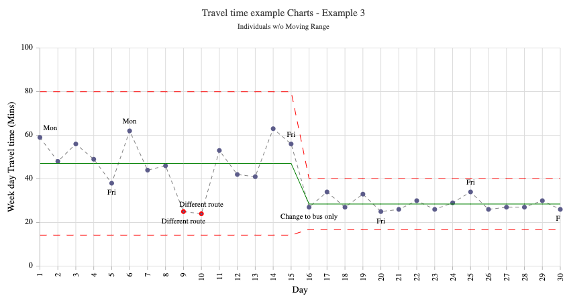
* The diagrams for all 3 scenarios were created using Aimi Analytics, part of a cloud-based Enterprise Innovation and Improvement management software that accelerates change programs, whilst reducing documentation time and creating a knowledge base that supports Learning Organisations (see link below for more information). https://aimihub.com/
Now consider scenario 3. Until day 15, you followed exactly the same approach as scenario 2, taking your usual route, except for days 9 and 10 when you took the 2-bus route. However, this time, after you had returned to your normal process, you decided that perhaps taking the new route seemed prove more convenient (despite being a bit more crowded). So, from day 16 onwards, for the remainder of the 6 weeks, you changed to the 2-bus route.
In doing so, you found that your average travel time reduced to just over 25 minutes. What’s more, the new process is proving to be more narrowly predictable, varying within a smaller margin. Based on this, unless there were unusual (or special) causes, you could feel confident that you could reach work by 8:40am if you left at 8am, or potentially allow you the flexibility to leave as late as 8:20. Of course, the latter premise would need to be tested and measured to be sure.
Measuring and looking at data over time, you can start to see patterns in the variation from which you can learn about the system at hand. The challenge is to first establish predictability in the variation by eliminating special causes, and then reduce the degree of it by making changes further back in the causal system, as was shown in scenario 3.
Thus, by way of exploring the causal factors in the system and how they impact the measures, you can begin to drive deliberate productive changes in your system that result in sustainable improvement. This is the basis of the next stream of science.
3. Learning
How do people learn? Individuals? Teams? Organisations?
Think of what it was like as a child. Very often you would learn things by exploration. Remember the time you finally learned to ride that bicycle (something you could only learn by experience, no matter how much instruction you were given, or how many times you were shown). Then you saw someone else riding along with no hands on the handlebar.
So, you formed a belief – “If they can ride with no hands, so can I!”. So, riding along, you tentatively let go with both hands, only to quickly grasp the handlebar again when you nearly lost control. Thinking again, you formed a theory that you were going to slow, hence the instability. So, you decided to try again, riding a bit quicker. For a few glorious minutes you were riding hands-free, until you were forced to grab control again. However, the experience reinforced your degree of belief that if you continued to experiment and practice, you would soon be gliding along like a hero, balancing your bicycle merely by the seat of your pants.
What you experienced was cycles of inductive and deductive learning. The feeling of rapid learning cycles like this can be exhilarating! So why do we stop doing this when we enter the workplace?
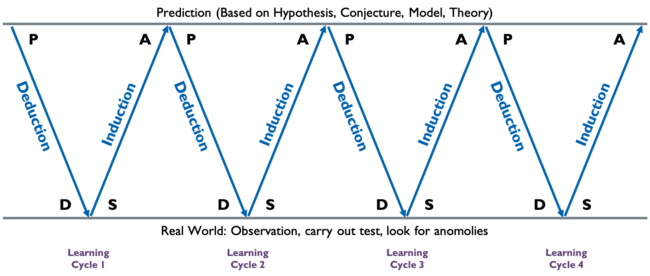
Source: Adapted from Figure 4.4, The Iterative Nature of Learning and Improvement, from “The Improvement Guide: A Practical Approach to Enhancing Organizational Performance”, 2nd Ed., Langley, Moen, Nolan, Nolan, Norman and Provost, Ch. 4
In fact, the most powerful way for operational teams to learn is to experiment with change openly as a team. By planning experiments as a team, it gives an opportunity to raise and examine unspoken assumptions, building alignment and strengthening team learning. Such learning can be done by applying the Scientific Method adapted for use in business in the form of PDSA Cycles of learning. We will address this topic also further in another article on the Accelerated Model of Improvement.
There is a lot around Second Order Learning and Double Loop Learning (A concept developed by Dr. Chris Agyris – see the HBR article link below7) that, again will be addressed in another article, but fundamentally this all about getting people to re-examine their assumptions of what they believe about a situation. This can best be done through trial and learning experimentation, having temporarily suspended judgement.
https://hbr.org/1977/09/double-loop-learning-in-organizations
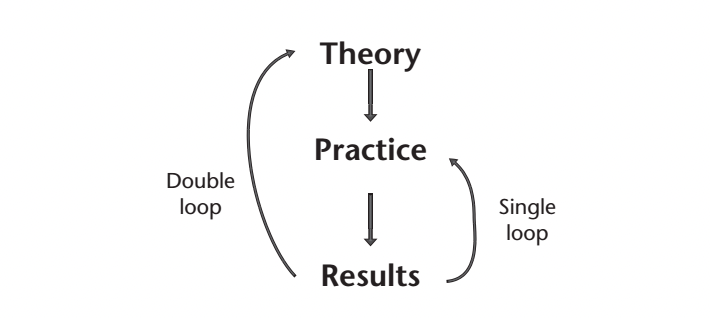
Single and Double Loop Learning. Diagram source: “Strategic Intelligence: Conceptual Tools for Leading Change”, Dr. Michael Maccoby, Fig 8.3, Ch. 8.
When leadership teams undertake team learning through experimentation, openly exploring assumptions and barriers to improvement, and encourage their teams to do the same thing below them, rapid improvements can result. By planning their business improvement with Enterprise Measurement Systems, using a Systems Map to focus their efforts on the processes, technologies and people aspects that will:
- Reduce costs without negatively impacting customer/patient experience.
- Improve customer/patient experience without increasing costs; or,
- Radically innovate to increase value for customers or population health outcomes,
… the organisation will have begun to take on the characteristics of a Learning Organisation, becoming increasingly successful in its chosen industry. Creating a Learning Organisation is a topic that will be addressed in yet another article.
4. Psychology
Paul Rulkens began his TEDx Maastricht talk in 2014 by relating a story about Einstein in 1942. He and his assistant had just walked out of an exam they had run, when the assistant asked Einstein, “Isn’t that exactly the same exam you gave to exactly the same class one year ago?”. Einstein responded, “Yes, exactly the same!”. The assistant pushed on to ask, “But Dr. Einstein, how could possibly do that?”. “Well …”, said Einstein, “The answers have changed!”8.
The concept of Psychology in the context of the System of Profound knowledge deals with Mental Models of the world around us (beliefs of what we view to be true), what motivates people to do the things they do on a daily basis and what would motivate change in how they work, think and behave. Very often they do what they do because they are sure it is the right thing to do, but when questioned about the reasons for doing so (see learning above), they often arrive at “because that is the way I was taught.”, or “because I believe it is the right thing to do.” So the question we must all ask is “How do we know?”. In other words, how can agreement be found in the understanding of the system at hand.
The first challenge in this sense, is to get people to agree to do the work (processes, roles & responsibilities) as it stands, in the most efficient and effective way possible, given the competences of the people involved. This means getting the different people to operate the process with consistency. Up to a point we can motivate people with various mechanisms to work harder or more productively.
We can try to improve the system by increasing the knowledge and skills of the people in the process through training. In rare cases, an improvement may come replacing them with people who are better matched to the job.
Often called process improvement, the more effective way to improve the system is by redesigning it. This means examining the processes, technologies, people and policies of the system, and experimenting with making changes that will result in improvement. To do this, people need to be engaged to the changes being made, whilst maintaining the operations of the rest of the system. To that point, how many times have you seen or experienced a change inflicted on people unwittingly or unwillingly, completely disengaging you? If only they had engaged you in the change, how differently you might have felt.
Furthermore, consider the challenges of changing people’s beliefs despite what might be ultimately a better outcome. The example of roundabouts in this Cheddar Youtube video below, is a perfect case of the psychology of change, and how human beliefs can both hinder and support change.
If you want change to be palatable and sustainable, you need to motivate people to suggest, lead and follow improvements, which is a different type of motivation than simply getting people to work with consistency. It requires a different level of leadership skill, including an understanding of individual and team motivations. What motivates some to be change pioneers, or early champions, and what motivates others to be laggards or even to resist change? Who are the influencers in the system and how might they contribute to, or hinder improvements?
This is the concept of Stakeholder Analysis, and it helps to have a working understanding of the fundamentals of the psychology of change when considering the stakeholders in the system. It has been long known that the human side of change can either make or break improvement efforts. In this it helps to understand Maccoby’s 5R’s of Motivation (Rewards, Recognition, Reasons, Responsibilities and Reasons – we will address this further in another article). In our experience, 80% of the reason that many innovation or improvement efforts fail is a lack of focus on, or skill in managing, the human side of change, where one or all of these 5R’s are either not addressed or misaligned. One of the most important aspects to address, as Simon Sinek points out, is the WHY of the change.
Why is it called the SYSTEM of Profound Knowledge?
So, we have talked about 4 different streams of scientific theory, that have deep practical implications in managing innovation and change in any organisation. Dr. Deming suggested that one need not be eminent in all or any of these 4 streams of knowledge in order to drive productive change, but one should have a working knowledge in how each stream contributes to the outcome of change. More importantly, it is the interplay between these streams that bring about truly deep insights – a System of Profound Knowledge.
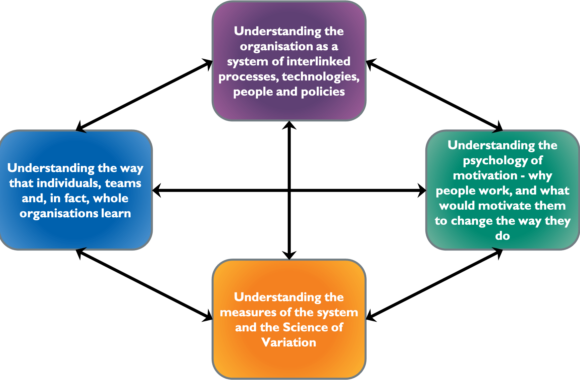
To wrap up our understanding of this subject, we often metaphorically depict the System of Profound Knowledge as a lens through which we might view managing any operating issues in an organisational system, and in attempting to make changes in the system or the products, services or experiences it creates, whether incremental improvement or radical innovation.
Hence Profound Knowledge Partners Asia often uses the term the Lens of Profound Knowledge to refer to what Dr. Deming describes the System of Profound Knowledge. As you can see, this mindset is so fundamental to our own way of thinking that we named our company in honour of it. We believe it is one of the most important business and leadership philosophies developed to date. It provides a scientific foundation to the art of Strategy, Innovation and Change from which the challenges of Business, Government, Healthcare and the World-at-Large might be approached in a more rapid, effective and holistic way.
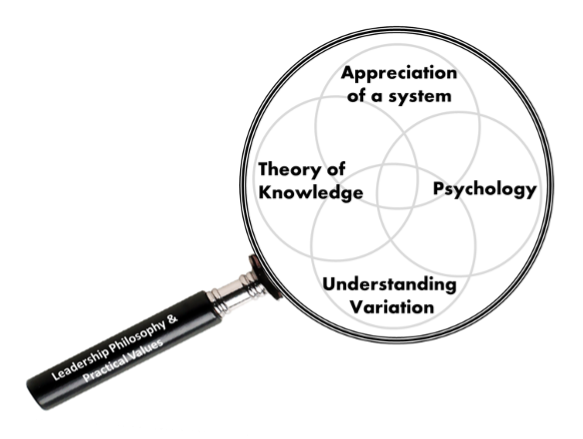
Profound Knowledge Partners Asia, and our global partners, help organisations move from theory to practice, taking these concepts to help enterprises form and refine better strategies, build capability for innovation and help establish programs of improvement that lead to increased revenue, reduced quality or service failures, better efficiency, enhanced staff engagement and improved customer/patient outcomes.
To learn more about this topic, and much more about Strategy, Innovation and Change, and how we can help you improve your business, please contact us by clicking on the link below:
Sources:
1. Deming Institute Website
https://deming.org/explore/sopk/
2. BBC Bitesize Guides
https://www.bbc.co.uk/bitesize/guides/zq8xk2p/revision/5
3. Royal College of Surgeons of England website
4. Merriam-Webster Dictionary Online
https://www.merriam-webster.com/dictionary/policy
5. “The Signal And The Noise: Why so many predictions fail – but some don’t”, Nate Silver, Penguin Random House, 2009
6. “The Improvement Guide: A practical approach to enhancing organizational performance”, Langley et al, 2nd Ed., Jossey-Bass, 2009
7. Harvard Business Review (Sept 1977), HBR Website
https://hbr.org/1977/09/double-loop-learning-in-organizations
8. TEDx Talk (Oct 2014), “Why The Majority is always wrong”, Paul Rulkens, Youtube: https://www.youtube.com/watch?v=VNGFep6rncY
I am raw html block.
Click edit button to change this html